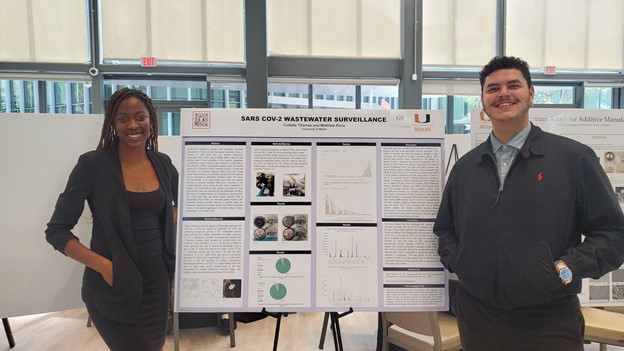How Stuff Works: Poop sleuths: Why researchers are tracking coronavirus in wastewater
By: Jennifer Walker-Journey | Feb 16, 2022
It’s comforting to assume that once you flush the toilet, the contents are out of sight, out of mind. But what most people probably don’t realize is that the stuff we flush away can tell a lot about the health of our community. And that stuff has proven to be a valuable resource in monitoring the coronavirus pandemic in communities across the country and around the world.
It’s called wastewater monitoring — or wastewater-based epidemiology — and since early in the pandemic, a growing number of researchers across the U.S. have been testing samples of untreated wastewater for coronavirus. They’ve found that levels of the virus in sewage plants give an early warning about levels of positive COVID-19 tests in the communities they serve.
“I’ve been teaching for a long time all the interesting things you can learn from toilets,” says Davida S. Smyth, Ph.D., an associate professor of microbiology at Texas A&M University-San Antonio. She should know. She runs the Smyth Lab where she and her undergraduate team study comparative microbial genomics and evolution. She’s also the daughter of a plumber and she’s focused much of her research into the wealth of information that goes into toilets.
What Our Poop Tells Researchers
Our poop is made up primarily of water, but the remaining 25 percent is a cocktail of undigested food residue, fats, salts, mucus and human pathogens like bacteria and viruses. If you’re infected with the coronavirus, which causes the COVID-19 infection, then it’ll show up in your excrement, too.
The stuff that washes down the drains of our toilets, as well as sinks, tubs and street gutters, travels for miles through our community’s sanitary sewer system and gathers with the waste from other homes into bigger and bigger sewer pipes. This river of communal sewage eventually flows into a local wastewater treatment facility where it is ultimately pasteurized and the harmful material removed.
Regularly monitoring wastewater samples over the course of time enables researchers to establish a trend analysis. These analyses have detected spikes and new variants days — even weeks — before COVID-19 testing via nasal swabs. And since all cities and towns have their own sewage plants, researchers can pinpoint where spikes will be and whether a new variant is emerging as one of concern.
How Is Wastewater Surveillance Helpful?
“Imagine if you had two weeks’ lead time in a potential outbreak situation at a dorm or a hospital or other facility,” Smyth says. “You could potentially target your interventions and maybe reduce the impact of that outbreak.”
For example, communities could ramp up messaging to alert the public to practice masking, social distancing and other measures to limit the spread of the virus as well as encourage testing and self-isolation for those who test positive.
Surveillance also gives researchers a better understanding of how the virus mutates and how those variants react to vaccines — factors that are vital to keeping the public safe. “We need to understand the virus because we don’t know where it’s going next,” Smyth says.
Wastewater epidemiology acts as a complementary approach for current infectious disease surveillance systems and an early warning system for disease outbreaks.
NATALIE SIMS; BARBARA KASPRZYK-HORDERN
Sewer Monitoring vs. COVID-19 Testing Surveillance
Public health officials have learned a lot about COVID-19 by tracking the number of positive tests by county, state, country and more. But testing has its limitations.
For starters, it requires people to actually get tested. Many do if they become exposed to the virus, have developed symptoms, or are required to do so for their jobs. But not everyone in a community chooses to get tested either because they don’t have health insurance, have no access to tests, aren’t showing symptoms or simply do not want to get tested. “If you don’t get tested then we don’t have any data from you,” Smyth says.
However, “everybody poops,” she adds. “Everybody has to go to the bathroom so [thanks to wastewater testing] we have the data on potentially every single person in a system.”
Of course, wastewater testing for coronavirus is not mandated so not all municipalities are testing. But many are voluntarily participating thanks to grants and other sources of funding including the CARES Act. Several municipalities created their own dashboards to share their data and trend analyses.
In September 2020, the Centers for Disease Control and Prevention (CDC) launched the National Wastewater Surveillance Systems (NWSS) to coordinate and build on the country’s capacity to track SARS-CoV-2 in wastewater samples collected at wastewater plants across the country. As part of that project, the agency recently unveiled a new CDC COVID Data Tracker where all the data on wastewater testing is centralized onto one dashboard for the public to view.
The CDC expects participation in the program to grow as health departments and public health laboratories further develop their capacity to coordinate wastewater surveillance. However, it’s still a developing field and there are limitations. Among them, treatment plants don’t capture homes on septic systems or communities served by decentralized systems that treat their waste, such as hospitals or universities. However, many colleges and universities are collecting their own data, including Atlanta’s Emory University, University of Miami and University of Buffalo to name just a few.
And while concentrations of the virus in wastewater sampling can indicate just how impacted a community is, it cannot tell exact numbers of those infected. But having all the data on one page — literally and figuratively — can offer a better picture of how the virus is impacting our country. “Having the CDC’s leadership and guidance is really going to help,” Smyth says.
Wastewater Epidemiology Is Not New
“Wastewater is very sexy right now. It’s all over the news,” Smyth says. “But here’s the thing — people have been using wastewater surveillance for years to look for things like polio, for example.”
Yep, that’s right. Researchers have been detecting and tracking various viruses in sewage for more than 50 years and have used the data to guide public health responses.
For example, polio has been eradicated in nearly all countries, thanks to the polio vaccine. But transmission is still ongoing in three countries where vaccines lag — Nigeria, Afghanistan and Pakistan. Rather than relying on reported cases of acute flaccid paralysis (AFT), a probable cause of polio, researchers have been looking in sewage to detect poliovirus shed in the feces of non-paralyzed people infected with polio.
Wastewater surveillance has also been used to detect other viruses such as hepatitis B and norovirus. Smyth says she is currently working to refine testing techniques to better monitor sewage plants for the flu — a virus, she says, that’s “very good at causing pandemics.”
Understanding the value of our waste “you see it in a whole new light,” Smyth says, referencing a comment a local sanitation utility employer recently said to her: “It’s only wastewater if you don’t use it.”




